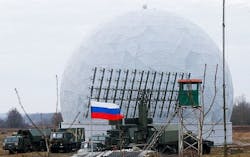New Russian directed-energy weapon could complicate U.S. military strategic planning
THE MIL & AERO BLOG, 7 July 2015. The Russian defense industry reportedly has developed a directed-energy weapon that can destroy or disable sophisticated electronic guidance and navigation systems in manned and unmanned aircraft and precision-guided missiles.
This electronic warfare (EW) weapon, which is yet unnamed, also reportedly can take out GPS navigation signals, radio communications equipment, and even orbiting satellites.
"The system will target the enemy’s deck-based, tactical, long-range, and strategic aircraft, electronic means, and suppress foreign military satellites’ radio-electronic equipment," says Yuri Mayevsky, CEO of the weapon's developer, Radio-Electronic Technologies Group (KRET) in Moscow.
The weapon, Mayevsky says, will be based on "ground-based, air-and seaborne carriers," which means fixed-based land sites, ground vehicles, aircraft, surface ships, and perhaps even submarines.
Assuming the news reports are true, this development could complicate U.S. military strategic planning, which for the past quarter-century has relied heavily on precision-guided munitions, GPS navigation, and tactical battlefield networking.
Related: Navy approaches industry for ideas on how to counter directed energy weapons
Such a weapon has the potential to neutralize or degrade the performance of U.S. and allied combat aircraft, cruise missiles, satellite-guided munitions like the Excalibur artillery shell, network-centric warfare setups, and many other high-technology military systems.
There's no word on how widely deployed a weapon like this could be in the future, how deployable it could be in difficult terrain or away from major sources of electric power, or how rugged, reliable, and maintainable this weapon could be in battlefield conditions.
A story from the Russian news agency TASS entitled Russia developing system capable of ‘switching off’ foreign military satellites, says Russian military leaders intend the weapon for anti-aircraft warfare, electronic warfare, and to disable satellite communications (SATCOM).
story continues below
Russian commanders say they will use the integrated multifunctional electronic warfare system for defensive purposes, and will deploy it to defend the country from aircraft, from cruise missiles, and from ballistic missiles.
Related: Pentagon proposes deep cuts in lasers and directed-energy weapons work in 2013 budget
"It will fully suppress communications, navigation and target location, and the use of high-precision weapons," says Vladimir Mikheyev, adviser to the KRET first deputy CEO. "The system will be used against cruise missiles and will suppress satellite-based radio location systems. It will actually switch off enemy weapons." Field tests are scheduled for as early as the end of this year.
This new weapon -- assuming it can be developed into a workable system -- raises a host of questions. First is when U.S. or allied military forces might be on the receiving end of a field test.
Just last Saturday, the fourth of July, U.S. jet fighters intercepted separate Russian TU-95 strategic reconnaissance aircraft off the coasts of California and Alaska. On the same day Russian President Vladimir Putin phoned U.S. President Barack Obama to wish him a happy Independence Day. He probes American air defenses and then offers us best wishes; you gotta admit it's a nice touch.
These probes of U.S. and allied air defenses have become common occurrences over the past year or two. It makes me wonder when or if those Russian spy planes might use a directed-energy weapon to turn off the avionics of the intercepting jets.
Related: Air Force wants ideas for high-power directed-energy weapons
Would if be an act of war if the interceptors were not shot down or seriously threatened? We just might find out, sooner than later. Another question: what is the U.S. military doing to defend against hostile directed-energy weapons? Believe it or not, there are programs in place.
The U.S. Office of Naval Research (ONR) in Arlington, Va., for example, has the Counter Directed Energy Weapons program (CDEW), which is looking for new ways of defending against hostile high-energy lasers, high-power microwaves, and other directed-energy weapons in the maritime domain.
This kind of research is going on in other military services, as well as at research institutions like Georgia Tech in Atlanta. Moreover, the U.S. military also is working on its own directed-energy weapons programs that should yield technologies with similar capabilities as the new Russian weapon.
It's all a reminder of the importance of electronic warfare in this day and age -- and of the kind of dangerous world we live in.


